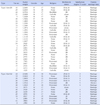Abstract
Methods
A Q-methodology which provides a method of analyzing the subjectivity of each type was used. Forty-three high school students classified 40 selected Q-statements into 9 points standard. The obtained data were analyzed by using the pc-QUANL program.
Results
High school students' subjectivity on childbearing were analyzed into two types: Type 1 turned out to be 'FOLS (family oriented life style)' and Type 2 'CINK (couple important no kid)'.
Conclusion
In order to resolve such problems as low birth rate and the advanced age of the population, effective youth and adult programs, policy and institution are required. The current demographic, economic and other factors such as personal values and policies may lower birth rate. In particular, youths' need for children and birth rate tend to be lower. There are positive and negative patterns in high school students' subjectivity on childbearing. Thus, national and social efforts are needed to change negative factors into positive ones. In order to maintain positive subjectivity on childbearing in high school students, it is necessary to apply family-centered educational programs and to implement birth-friendly and realistic programs for promoting child birth.
Figures and Tables
Summary Statement
▪ What is already known about this topic?
The current demographic, economic and other factors such as personal values and policies lower birth rate. In particular, youths' need for children and birth rate tend to be lower.
▪ What this paper adds?
There are positive and negative patterns in high school students' subjectivity on childbearing.
▪ Implications for practice, education and/or policy
National and social efforts are needed to change negative factors into positive ones. In order to maintain positive subjectivity on childbearing in high school students, it is necessary to apply family-centered educational programs and to implement birth-friendly and realistic programs for promoting childbirth.
References
1. Aldieri L, Paolo VC. Education and fertility: An investigation into Italian families. Int J Soc Econ. 2012. 39:254–263. http://dx.doi.org/10.1108/03068291211205686.

2. Baek ML, Lee KS. University students' perception of childbirth. J Korean Soc Matern Child Health. 2008. 12:92–103.
3. Bang YY. A study on the direction of childbirth promotion policies. 2010. Seoul: Seoul National University;Unpublished doctoral dissertation.
4. Castles FG. The world turned upside down: Below replacement fertility, changing preferences and family-friendly public policy in 21 OECD countries. J Eur Soc Policy. 2003. 13:209–227. http://dx.doi.org/10.1177/09589287030133001.
5. Choi SH. How to raise Korea's fertility rate. J Women Econ. 2006. 3:67–92.
6. Do MH. The effect of college student's awareness on marriage and childbirth to future marriage and childbirth. Korean J Fam Welf. 2011. 16:163–178.
7. Duvander AZ, Lappegard T, Andersson G. Family policy and fertility: Fathers' and mothers' use of parental leave and continued childbearing in Norway and Sweden. J Eur Soc Policy. 2010. 20:45–57. http://dx.doi.org/10.1177/0958928709352541.

8. Evens EM. Conceptualizing and testing a new measure of fertility intentions: A mixed methods exploration of factors that affect the achievement of childbearing plans. 2010. Chapel Hill: The University of North Carolina;Unpublished doctoral dissertation.
9. Haan P, Wrohlich K. Can child care policy encourage employment and fertility?: Evidence from a structural model. Labour Econ. 2011. 18:498–512. http://dx.doi.org/10.1016/j.labeco.2010.12.008.

10. Ham JY, Park K. The relationships of stress, alexithymia and somatization of adolescents-focused on the highschool student. J Stud Guid Couns. 2005. 18:77–90.
11. Heo H, Hwang JY, Kim DG, Lee HJ, Sim JC, Yang HS. A clinical study of pregnancy and delivery in pregnant women 35 years and older. Korean J Obstet Gynecol. 2004. 47:458–463.
12. Jo SC, Kim NS. A study on the outlook on marriage and delivery will of high school students. Korean J 21Century Soc Welf. 2011. 8:153–176.
13. Kang KS, Byun MH, Jung EM. A study on factor analysis of affecting low fertility using time-series data. Korean J Fam Welf. 2005. 10:127–145.
14. Kang PS, Jeong YK, Hwang TY. Perception and attitude of female high school students towards marriage and childbirth. J Korean Soc Matern Child Health. 2006. 10:31–39.
15. Kim HK. Q methodology: Philosophy, theories, analysis, and application. 2008. Seoul: Communication-books.
16. Kim HS, Park JS, Jo EJ. The perceptions of marriage and childbirth of health care fields college students. Korean J Health Serv Manag. 2011. 5:131–146.

17. Kim KS, Oh JH. A study of attitude related to college women towards childbirth. J Korean Soc Sci Study Subj. 2007. 15:149–161.
18. Kim TH. A scheme for prosocial marriage and child values of Korean primary and high school students. Health Welf Policy Forum. 2007. 124:15–24.
19. Korea Institute for Health and Social Affairs. Health and welfare information. 2008. Retrieved June 14, 2012. from http://www.kihasa.re.kr/html/jsp/.
20. Kwon HJ, Kim YJ, Kwon SJ, Park SA, Ahn YM, Lee GS, et al. College students' perception on childbirth as a challenge. Korean J Youth Stud. 2011. 18:175–200.
21. Kwon YE, Kim UC. Value of children and fertility. J Child Educ. 2004. 13:211–226.
22. Lee KS, Jung SJ, Park JA, Shin YJ. A study on psychological variables related to low fertility. Korean J Woman Psychol. 2009. 14:93–108.
23. Lee MR. Effects of childbirth encouragement policies on unmarried women's motivation for childbirth and childrearing. Korean J Fam Welf. 2009. 14:75–96.
24. Lee SS. A study on impact of the change in values on marriage and fertility behaviors. Health Soc Welf Rev. 2006. 26:96–140.
25. Lee YJ, Kim JI. Analysis of factors affecting low birthrate & occupation sensitive birth assistance programs for working women. Soc Sci Res. 2009. 35:61–90.
26. Paeng KY, Kim JR, Kang YS, Hong DY. The related factors of attitude toward childbirth among female students in junior, senior high school and university. J Agric Med Community Health. 2007. 32:63–73.

27. Shin HY, Bang ER. Youth perceptions on childbirth & marriage. J Future Oriented Youth Soc. 2008. 5:95–113.
28. Sohn SY. Causes of low fertility rate Korean society and suggestions for family-friendly policies. Fam Cult. 2005. 17:285–316.
29. Statistics Korea. Demographics-population trends survey. 2012. Retrieved June 11, 2012. from http://kosis.kr/abroad_01List.jsp?parentId=A.
30. Torr BM, Short SE. Second births and the second shift: A research note on gender equity and fertility. Popul Dev Rev. 2004. 30:109–130. http://dx.doi.org/10.1111/j.1728-4457.2004.00005.x.

31. Wheeler M. Contemporary topics in low fertility: Late transitions to parenthood and low fertility in East Asia. 2011. Philadelphia: University of Pennsylvania;Unpublished doctoral dissertation.
32. Zamac J, Hallberg D, Lindh T. Low fertility and long-run growth in an economy with a large public sector. Eur J Popul. 2010. 26:183–205. http://dx.doi.org/10.1007/s10680-009-9184-z.




 PDF
PDF ePub
ePub Citation
Citation Print
Print








 XML Download
XML Download